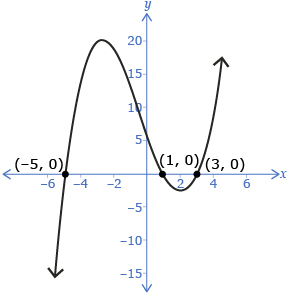Lesson 1
1. Lesson 1
1.8. Explore 4
Module 3: Polynomial Functions
In Try This 2 you probably discovered that x-intercepts are directly related to the factors of a polynomial function. The following example illustrates the relationship between a polynomial function and the x-intercepts of its graph.
What are the x-intercepts of the graph of f(x) = 0.4(x − 3)(x + 5)(x − 1)?
You need two key pieces of information:
- All x-intercepts have y-coordinates of zero.
- The zero-product property: If s and t are real numbers and st = 0, then either s must be zero, t must be zero, or they are both zero. (This can be extended to the product of any number of numbers.)
The zero-product property may sound confusing, but it’s just a formal way of stating what you already know: if you multiply some numbers together, the only way to get zero is if one (or both) of those numbers is zero. Here are some examples:
- 5 × 0 = 0
- 0 × 17x − 3 = 0

Since the x-intercepts have y-coordinates of zero, you are looking for values that make the following equation true:
0.4(x − 3)(x + 5)(x − 1) = 0
The left side is the product of four real numbers: 0.4, x − 3, x + 5, and x − 1. The only way a product of numbers can be zero is if one (or more) of those numbers is zero (the zero-product property). Thus,
0.4 = 0 (1)
x − 3 = 0 (2)
x + 5 = 0 (3)
x − 1 = 0 (4)
Equation (1) is false, so it can be ignored. Solving the other three equations gives three values of x that make the original equation true:
x = 3
x = −5
x = 1
These make the polynomial function zero, so they are the x-intercepts. Graphing the polynomial function confirms this.

Self-Check 3
State the x-intercepts of the graphs of the following functions without graphing them.